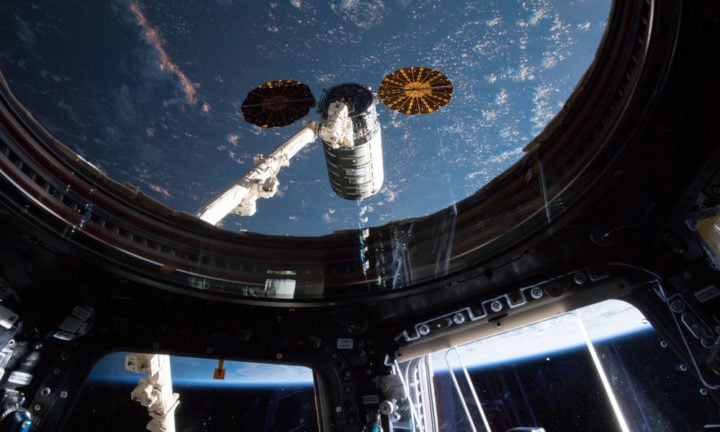At NASA’s Cold Atom Lab facility aboard the International Space Station, an international team of scientists produced a quantum gas containing two types of atoms for the first time in space. The achievement, outlined in a new study published in Nature, marks another step toward bringing quantum technologies currently available on Earth into space.

The Cold Atom Lab on the International Space Station produces clouds of “ultracold” atoms, the absolute coldest temperature that matter can reach. Through experiments at the lab controlled remotely on Earth, a team of international researchers produced Bose-Einstein condensates—a quantum state of matter made from an atomic gas cooled to temperatures close to absolute zero. Illustration by JPL/NASA
Through experiments controlled remotely on Earth, the researchers produced Bose-Einstein condensates—a quantum state of matter made from an atomic gas cooled to temperatures close to absolute zero.
Nicholas Bigelow, the Lee A. DuBridge, Professor of Physics and a professor of optics at the University of Rochester, says these quantum tools can be used to enhance the study of the essence of quantum matter, aid in the navigation between planets, and help solve mysteries of the universe and deepen our understanding of the fundamental laws of nature.
Reaping the benefits of zero gravity
“There are a lot of things in fundamental physics where being in the presence of gravity actually limits how precise a measurement you can make,” says Bigelow, director of the NASA-funded Consortium for Ultracold Atoms in Space. “Removing gravity allows you to make a much longer observation time to get more precision in the measurement, and it allows you to see delicate effects that might be masked by gravity.”
With this new capability, the Cold Atom Lab can now study not only the quantum properties of individual atoms, but also quantum chemistry, which focuses on how different types of atoms interact and combine in a quantum state. Researchers will be able to conduct a wider range of experiments with the Cold Atom Lab and learn more about the nuances of performing them in microgravity.
That knowledge will be essential for harnessing the one-of-a-kind facility to develop new space-based quantum technologies.
One mystery the scientists aim to chip away at involves the equivalence principle, which holds that gravity affects all objects the same regardless of their mass. Part of Albert Einstein’s general theory of relativity—the backbone of modern gravitational physics—the principle doesn’t neatly match up with the laws of quantum physics, which describe behaviors of small objects like atoms.
Scientists have already experimented with atom interferometers on Earth to see if the equivalence principle holds true at atomic scales, but they can test it more precisely in space at the Cold Atom Lab.
A route to understanding dark energy—and to better sensors and clocks
Bigelow says the scientists plan to run experiments using a two-atom interferometer and quantum gases to measure gravity with high precision to learn about the nature of dark energy, the mysterious driver behind the universe’s accelerating expansion. What they learn could lead to developing precision sensors for various applications.
“We could make sensors extremely sensitive to small rotations and essentially use these cold atoms in the Bose-Einstein condensate to make gyroscopes,” says Bigelow.
“These gyroscopes could give us a fixed reference point in space that could be used for deep space navigation. We’re also developing several things that could lead to better clocks in space, which are crucial to so many things in modern life such as high-speed internet and GPS.”
Source: University of Rochester

